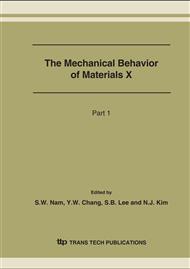p.489
p.493
p.497
p.501
p.505
p.509
p.513
p.517
p.521
Microstructure and Bonding Strength in Overlaying of Stellite 6 Alloy on Spheroidal Graphite Cast Iron by Plasma Transferred Arc Process
Abstract:
In this study, stellite 6 alloy was overlaid on spheroidal graphite (SG) cast irons with various carbon contents (1.5wt%~3.8wt%) and a fixed silicon content (approximately 2.5wt%) using the plasma transferred arc (PTA) process at different overlaying current (140A~220A) while the travel speed of the PTA torch was maintained constant. Results indicated that the solidification structures of the stellite 6 overlayers were dendritic and had a large amount of interdendritic precipitates (M7C3 and M23C6 carbide) after the satellite 6 alloy had been overlaid on SG cast irons with different carbon contents (1.5wt%~3.8wt%) at a low overlaying current (I=140A). The partially melted zones of the substrates below the carbide-containing interfacial layers consisted of eutectic carbides (ledeburites) and fine pearlites. The amount of the carbide-containing interfacial layers and ledeburites increased following the increase in the overlaying current. The results of the tearing test reported that the occurrence of the carbide-containing interfacial layers was detrimental to the bonding strength between the overlayers and the substrates. The metallography of the fractured area of the tearing specimens after the bonding strength test revealed that fractures always occurred at the carbide-containing interfacial areas. On the other hand, the overlayers were rich in iron content when the overlaying currents were high (I=190A and 220A). Owing to the dilution effect, the matrices of the overlayers were α-Fe with lamellar M7C3 carbides. The results of the tearing test indicated that the bonding strength of the overlaid specimens was relatively low, and fractures always occurred in these highly diluted overlayers.
Info:
Periodical:
Pages:
505-508
Citation:
Online since:
August 2007
Authors:
Price:
Сopyright:
© 2007 Trans Tech Publications Ltd. All Rights Reserved
Share:
Citation:


